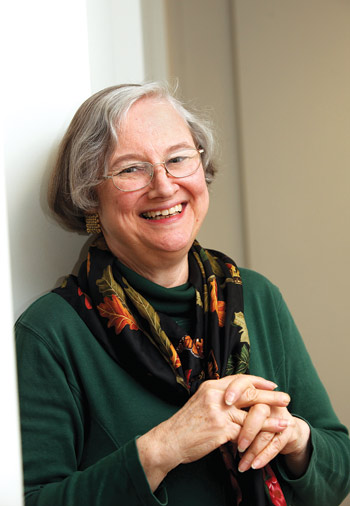Lines in the Sand:

Photo by Bruce Gilbert
As an institution, the Catholic Church has boundaries.
A particular belief system grounds the church’s identity. Special rituals are in place to initiate members and later establish roles in the community. These members largely adhere to church doctrine and the associated practices.
In short, there are certain demarcations that make the church what it is.
But the question is, who determines what these are?
According to Maureen Tilley, Ph.D., professor of theology and Augustine scholar, the boundaries that make the church what it is today date back more than 1,700 years.
Tilley, who was awarded a Thomas F. Martin Saint Augustine Fellowship at Villanova University for Fall 2011, researches Christianity in North Africa during the late antiquity era, a period spanning roughly 180 A.D. to 700 A.D. In particular, she investigates the relationship between two prominent Christian communities of this era, the Catholics and the Donatists, the latter of whom she describes as “the Bible-thumpers of North Africa.”
“This is a group of folks who believed in a smaller, purer, holier church, versus [fourth-century North African bishop] St. Augustine of Hippo, the major Catholic figure [of this time period], who believed that the church was a home for both saints and sinners,” Tilley said.
For Donatists, church boundaries were stringent. Crossing them meant that one could only formally rejoin the church after he or she was re-baptized.
“Their ritual of ‘second chances’ was re-baptism, which is what made them distinctive from the Catholics, whose ritual of reintegration was penance,” Tilley said.
Though both Christian, the Donatist and Catholic communities frequently locked horns. As Tilley has uncovered—her current research project is a translation of the entirety of Augustine’s anti-Donatist treatises—Augustine wrote copiously to persuade Donatists of Catholic teachings and practice.
His arguments worked. By the early fifth century, Donatism began to give way in some areas to Catholicism. But as the two sects combined, a thorny issue arose for the early church. Bishops and church leaders were now challenged with incorporating many individuals and even entire parishes of former Donatists transitioning to the sect.
“Before the Donatist controversy, people had not thought systematically about who’s in the church and if someone commits a major sin, how they get back in,” Tilley explained. “This controversy helped the church to figure out how to reincorporate people and to come up with a consistent practice.”
During this transition, Augustine set forth a number of practices to assimilate new and returning members into the church. He particularly helped to define penance—a religious ritual whereby a sinner could atone for his or her wrongdoing—for people returning to the church after committing heresy, i.e., holding deviant doctrinal beliefs. During this process, the penitent was required to acknowledge in the presence of the bishop that he was a sinner and to refrain from receiving the Eucharist until the bishop determined the end of the penitential period.
In addition to helping to incorporate the Donatists, though, the penitential process also served to delineate the boundaries of the church itself.
“The fluidity and diversity of practices have implications for modern ecclesiology, that is, the theology of the church, which asks, what is the church? How do you find it? Who’s on the inside? Who’s on the outside?” she said.
The practices that Augustine established have endured, Tilley pointed out. Today, the church has a structure in place to incorporate new Catholics coming from other Christian denominations. In addition, the modern version of penance for returning members remains similar to the ritual that Augustine advocated.
“What Augustine is famous for is constructing a sacramental theology of baptism and penance that continues to the present,” Tilley said. “[This involves] finding a welcome for repentant sinners—not holding them at arm’s distance, but enfolding them—and having a greater tolerance for evil members of
the church.”
Though her research generally comprises textual study, Tilley has also traveled to Algeria and Tunisia to visit archaeological sites that host the remains of churches and baptisteries of the late antiquity period—some of which Augustine himself frequented during his time.
“It’s a matter of putting texts and archaeological sites together to solve problems of textual interpretation, as well as the interpretation of archaeological sites,” she said.

